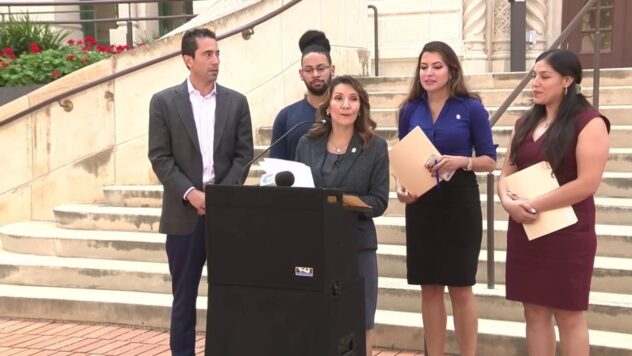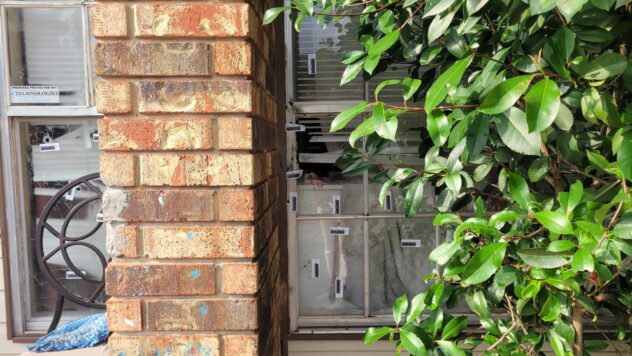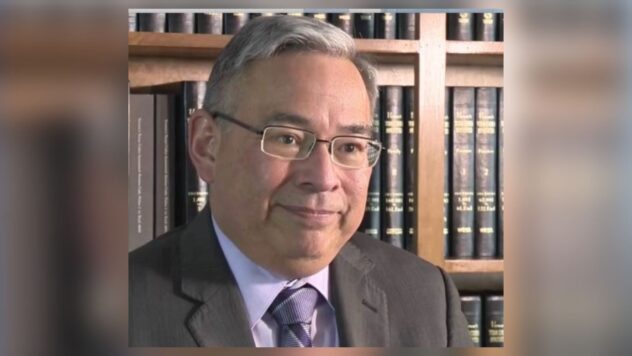Missed Target: Democrats hoped to paint the state blue in 2020. Here’s what went wrong.
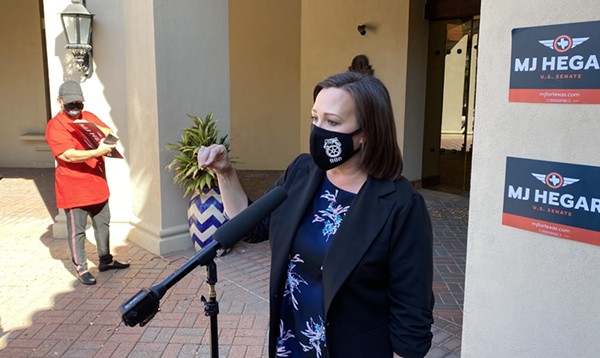
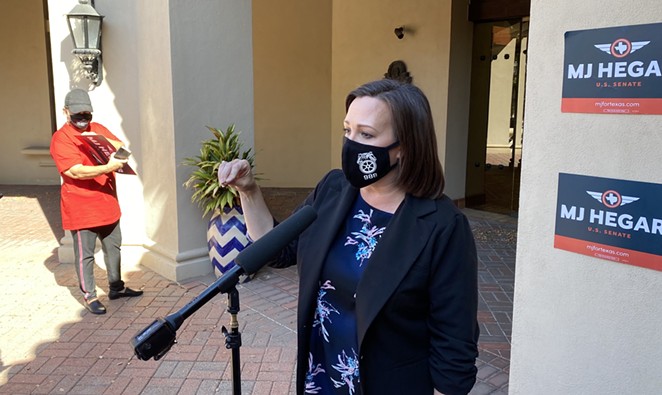
- Sanford Nowlin
- Democratic Senate candidate MJ Hegar addresses reporters during a recent stop in San Antonio.
Democrats spent big and dreamed even bigger in Texas this election cycle. And, once again, they fell desperately short.
Emboldened by promising polls and a 12-seat gain in the Texas House during 2018, the party had hoped to crack Republicans’ long dominance here, winning their first statewide office in nearly three decades and racking up the nine seats needed to pull the House under their control.
Neither of those things happened, and in the end, Democrats lost one seat in the House and replaced it with a single gain, leaving the party where it was in 2018. The San Antonio seat of incumbent State Rep. Steve Allison — one Dems had targeted to flip — remains in Republican control with challenger Celina Montoya falling seven points short.
“At the end of the day, they were trying to run against incumbents,” said veteran Democratic political consultant Laura Barberena. “If you’re going to beat an incumbent, you have to give people compelling reasons to vote against them. In the absence of that, you’ve got to drive turnout, and I just don’t think that happened.”
Despite a rush of outside spending and a rival with a smudged record, Chrysta Castañeda, a Democrat seeking a slot on the important oil-and-gas regulatory body the Texas Railroad Commission, fell 10 points shy. Many observers had given her the best hope of breaking the Dems’ nearly 30-year losing streak at chasing statewide races.
The outcome for the Lone Star State’s national offices were just as grim.
Democrat MJ Hegar, a decorated Air Force helicopter pilot, forced three-term incumbent Sen. John Cornyn to burn through a massive reelection war chest that started at $12 million before the race was underway. Even so, he beat her by 10 points.
Gina Ortiz Jones, a Democratic rising star, lost a close race to political novice Tony Gonzales to represent retiring Republican U.S. Rep. Will Hurd’s sprawling 23rd District, including part of San Antonio. She’d come within 900 votes of winning the same seat in 2018, making the defeat all the more painful.
Freshman U.S. Rep. Chip Roy bested former state Sen. Wendy Davis to hold his spot representing the 21st District, which includes San Antonio and the Hill Country. Democrats targeted the seat, sensing that Roy, a controversial Tea Party firebrand, was a poor fit for the district’s increasingly suburban demographics.
While President Donald Trump’s six-point win over Joe Biden this election cycle was the second-closest statewide race for the White House in the past quarter century, Democrats’ much-vaunted momentum in the suburbs seems to have stalled, said Southern Methodist University political scientist Cal Jillson.
“I think Democrats’ success in 2018 in the Texas House was picking the low hanging fruit,” he said. “It was also a period when change was coming to the suburbs, in that voters there were looking for more balance and not just Republican candidates all the time. But it doesn’t look like that continued this election cycle.”
Trinity University Political Science Professor Juan Sepulveda said Democrats had reason to be excited about 2020, especially with new Latinx voters joining the rolls. However, he said they were overly optimistic about how another demographic change would help their chances: the influx of new voters from outside the state.
“The data shows that many of the people leaving California, Oregon or Washington are leaving because of taxation and some issues that are likely to drive them to the Republican Party,” he said.

- Twitter / Roland Gutierrez
- Roland Gutierrez, who won a seat in the Texas Senate, meets potential voters in San Antonio.
Bright spots
That’s not to say Tuesday’s election was devoid of victories for Democrats.
Texas Rep. Roland Gutierrez, D-San Antonio, beat State Sen. Pete Flores, R-Pleasanton, by a three-point margin in the race to represent District 19, a sprawling Democratic stronghold that stretches from San Antonio through West Texas.
Beyond painting the district blue again, Gutierrez’s victory ends the 19-seat supermajority that had allowed Republicans to bring bills to debate in the full Senate without support from across the aisle. That’s a loss for Lt. Gov. Dan Patrick, who’s used the supermajority to force the chamber hard to the right.
What’s more, observers say, Tuesday’s results show Republicans had little success in the state’s growing urban areas. Even though San Antonio-area progressives felt a sting from the losses by Jones and Davis, the three Democrats representing the rest of the city’s congressional delegation — Joaquin Castro, Lloyd Doggett and Henry Cuellar — handily won reelection.
Indeed, in Bexar and the state’s four other largest urban counties with dependable Democratic majorities, 2.6 million voters cast ballots for Biden, up from the 1.9 million who did so for Hillary Clinton in 2016, according to an analysis by advocacy group Progress Texas.
Here’s the problem: that gain was at least partially offset by increased turnout for Trump in rural counties that skew Republican. This cycle, 2.3 million in those counties turned up to support the president, compared to 2 million in 2016, according to the same analysis.
Those results are more indicative of the divided nature of the electorate than Democrats’ failure to mobilize urban and suburban voters, argues Ed Espinoza, executive director of Progress Texas.
“Just because things didn’t go our way doesn’t mean it wasn’t a competitive election,” he said. “When you look at the trend, it’s going in the right direction.”

- Twitter / Tony Gonzales
- Republican congressional candidate Tony Gonzales on one of his many visits to counties in the district he ran to represent.
Rethinking the ground game
Even so, political observers say some of the high-profile defeats this cycle point to problems the Democratic Party still needs to overcome.
For an understanding on where things went wrong in 2020, GOP political strategist Matt Mackowiak suggests Democrats look at Jones’ District 23 race, which many favored her to win.
Jones largely ran a virtual campaign in response to the pandemic, relying on Zoom meetings and phone calls to interact with constituents. Meanwhile, her opponent made frequent appearances across the massive district.
The Gonzales campaign knocked on 27,000 doors in the past six weeks and the candidate himself visited all 29 districts in the county twice in the past two months alone, according to Mackowiak.
“Showing up during the race is important,” he said. “If you’re not showing up to talk to the constituents when you’re running, they know you’re not going to show up once you’re elected.”
To be sure, Gonzales repeatedly made the false allegation that Jones lived in Washington D.C. instead of the district, even though she actually resides on San Antonio’s West Side. Absurd as the claim may be, observers say it was hard for Jones to effectively rebut it when she wasn’t visiting counties around the district.
As most expected, Democrats landed wins in many counties along the border, but data suggests that the party didn’t invest enough resources in South Texas or reach out meaningfully in heavily Latinx areas outside the big cities. Biden picked up a combined 17 percentage points in the state’s 28 counties near the U.S.-Mexico border, according to a Texas Tribune analysis. In contrast, Hillary Clinton commanded a 33-point margin in those same counties in 2016.
Experts argue that slide came because national Democrats failed to launch a significant organizing program in deep South Texas. The party, they add, simply can’t keep assuming the state’s Latinx voters will continue supporting the party without meaningful outreach.
“Both parties have taken this group for granted,” said Purdue University political science professor James McCann. “Republicans have largely assumed they don’t have a chance with winning with Hispanic voters, while Democrats just assume they’re reliably going to vote Democrat. Both of them are wrong.”
McCann is co-author of Holding Fast: Resilience and Civic Engagement Among Latino Immigrants, a book based on a national study of Latino communities that argues first-generation Latinx immigrants are eager to engage in politics but don’t share Black Americans’ strong identification with the Democratic party.
In the wake of the election, the thesis seems prescient.
Tailoring the message
Whether it’s Hispanic voters in the Rio Grande Valley, suburban voters in swing districts or those in rural counties, political observers say Democrats can’t simply rely on mobilizing tried-and-true voters if they want to build on 2018’s gains.
Some point to Beto O’Rourke’s campaign that cycle as a potential model. His narrow-miss U.S. Senate campaign took him to every county in the state, energizing progressive voters who feel overlooked and convincing persuadable non-Democrats that the party isn’t a socialist cabal intent on outlawing red meat and hunting rifles.
“As much as we’ve gotten good at turnout, we’re going to have to get better at persuasion,” Espinoza of Progress Texas said.
Still, Espinoza acknowledges that many voters make their decisions based on identity rather than policy issues. And when it comes to urban versus rural Texans on matters of identity, there’s a “Grand Canyon-sized gulf.”
Republican strategist Mackowiak said until Democrats can find a message that lines up better with Texans’ interests in gun rights, individual liberties and other issues that veer from the national platform, they’re unlikely to expand their appeal.
“The national Democratic Party platform is not a winner in Texas,” he said. “It may be a winner in liberal places like New York and California, but it’s not working in Texas districts that Democrats need to win.”
Texas Democratic Party Chairman Gilberto Hinojosa acknowledged that party must do some soul searching in Tuesday’s wake and identify new strategies. Nonetheless, he’s not counting 2020 as a defeat.
“Any pundit who claims ‘Democrats lost Texas’ can’t see the forest for the trees. We have been making ground year, after year, after year, because we have been fighting for this,” he said. “Every newly registered, first-time young voter will be even more prepared to vote in the next election. When everything has been stacked against us—gerrymandering, voter suppression, voter intimidation — we did not give up. We will not give up after the closest we’ve come in a generation to delivering our electoral college votes to a Democratic presidential candidate.”
Put up or shut up
Even though this cycle proved disappointing for state Democrats on many levels, they’re going into the 2021 legislative session with a considerably stronger hand than they had in 2017 — and at least a slightly better one than they did in 2019.
Republicans retained their House majority, but it’s still slim, meaning there’s more pressure to work across the aisle than in years past. Gutierrez’s Senate win will force the GOP to sway some Democrats if it wants to bring legislation up for full debate. Otherwise, Patrick will need to enter another partisan scrap to change the rules.
Beyond that, the session will also be put-up-or-shut-up time for the controlling party, according to Lege watchers.
State lawmakers face the daunting challenge of crafting a new budget at the same time as they shore up revenues put through the meat grinder by the COVID-19 pandemic. At the same time, cities such as San Antonio are expected to push for police reform and LGBTQ+ activists are determined to force a conversation on the statewide lack of anti-discrimination protections.
Political observers don’t expect Republicans to rise to the challenge by finding new sources of revenue or innovative solutions. That’s likely to mean further deep cuts to education and other programs favored by Texans of both parties.
What’s more, top-of-the-ballot Republicans will enter the 2022 election year with new vulnerabilities.
Polls show Gov. Greg Abbott’s popularity has plummeted due to his confusing, stop-start approach to handling the pandemic. What’s more, observers warn he’ll likely face a challenge from the right, perhaps from social conservative Patrick, which could further damage his prospects.
Should Patrick instead choose to run for reelection as Lt. Governor, he’ll be lugging baggage such as his failed bathroom bill and recent pronouncements that old people should be willing to die from COVID-19 to save the economy. Even though Patrick outspent his Democratic opponent Mike Collier six-to-one in 2018, he eked out less than a five-point win.
And then there’s Attorney General Ken Paxton, whose latest scandal involves a raft of top aides calling for his investigation for bribery and abuse of office. And that’s on top of the five-year-old securities fraud indictment his legal team has been dragging out to avoid trial.
If Paxton’s political career survives into 2022, he’ll likely face a challenge from within his own party, creating yet more GOP turmoil.
Democrats may not have been able to recast Texas as a blue state or even a purple state this go-round, but observers say Sen. John Cornyn’s 2018 warning that the state is no longer “reliably red” should be no less of a warning to the GOP going forward.
While Democrats are retooling their strategy in the wake of 2020, SMU’s Jillson says Republicans would be well advised to do the same. The state’s demographic changes may not have brought a blue wave this cycle, but they’re real and they’re not yet done.
“You can’t continue going along with Dan Patrick on all of the issues and expect to be able to win Hispanic and Asian voters,” Jillson said.
Stay on top of San Antonio news and views. Sign up for our Weekly Headlines Newsletter.


